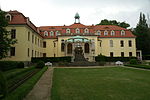Meissen Cathedral
Buildings and structures in Meissen (district)Burial sites of the House of WettinGerman church stubsLutheran cathedrals in GermanyLutheran churches converted from Roman Catholicism ... and 4 more
Lutheran churches in SaxonyMeissenPre-Reformation Roman Catholic cathedralsSaxony building and structure stubs

Meissen Cathedral or the Church of St John and St Donatus (German: Meißner Dom) is a Gothic church in Meissen in Saxony. It is situated on the castle hill of Meissen, adjacent to the Albrechtsburg castle and forms a critical centrepiece of the iconic Meissen skyline overlooking the River Elbe in the valley below.
Excerpt from the Wikipedia article Meissen Cathedral (License: CC BY-SA 3.0, Authors, Images).Meissen Cathedral
Domplatz,
Geographical coordinates (GPS) Address Website Nearby Places Show on map
Geographical coordinates (GPS)
| Latitude | Longitude |
|---|---|
| N 51.166111 ° | E 13.471389 ° |
Address
Burgberg Meißen
Domplatz
01662 , Niedermeisa
Saxony, Germany
Open on Google Maps








